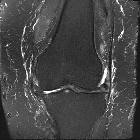Gonarthrose










Osteoarthritis (OA) of the knee is very common and is a major cause of morbidity, especially in the older population.
Terminology
The term early osteoarthritis of the knee has been proposed and has been defined as meeting three main criteria :
- knee pain
- ≤ Kellgren-Lawrence grade 2 on radiographs
- arthroscopic cartilage lesion and/or OA-related MRI findings such as subchondral bone marrow lesions and/or cartilage and meniscal degeneration
Epidemiology
Knee OA is very common and is the most common joint disease in the elderly. In the community, it is estimated to affect ~12.5% of patients >45 years .
The medial femorotibial joint compartment is more commonly affected and often more severe compared to the lateral .
Radiographic features
The hallmarks of knee osteoarthritis are the same for most other joints :
- joint space narrowing
- usually asymmetric, typically of the medial tibiofemoral compartment, and/or patellofemoral compartment
- <3 mm on weight-bearing knee radiographs is considered a finding of absolute joint space narrowing with a normal joint space >5 mm
- weight-bearing radiographs will demonstrate more joint space narrowing than non-weight-bearing radiographs, hence affecting the radiographic severity
- subchondral sclerosis
- marginal osteophytes
- subchondral cysts (geodes)
- altered shape of the femoral condyles and tibial plateau
Plain radiographs are the workhorse of imaging including follow-up, although there is a poor correlation between radiographic findings and clinical symptoms .
The initial study of any patient with suspicion of knee osteoarthritis should include a Rosenberg view, a PA radiograph with weight-bearing and 45 degrees of flexion, which is more sensitive to detect joint space narrowing .
Grading
MRI
The following features are seen additionally on MRI :
- effusion and synovial thickening / synovitis
- subchondral bone marrow edema and/or cysts
- cartilaginous defects (partial or full-thickness)
- bursitis
- iliotibial band syndrome
Treatment and prognosis
Non-operative management involves simple analgesia and weight loss. However, patients will often eventually require joint replacement. Total knee joint replacement is effective. Unicompartmental joint replacement may be considered in some institutions for cases where the disease is predominantly isolated to a single joint compartment.
Differential diagnosis
Other causes of degenerative joint disease, for example:
Siehe auch:
- Chondromalacia patellae
- Klassifikation Gonarthrose nach Kellgren Lawrence
- Arthritis Knie
- Ahlbäck classification system in assessing osteoarthritis of the knee joint
und weiter:

 Assoziationen und Differentialdiagnosen zu Gonarthrose:
Assoziationen und Differentialdiagnosen zu Gonarthrose:

